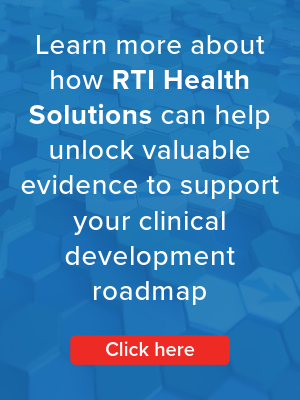
Article written by Anne Heyes, MBA
Vice President, Value and Access (Europe)
RTI Health Solutions
Strategic Development of Health Technologies with HEOR Integration
 The development of any new health technology requires a carefully crafted strategy to ensure successful market entry, adoption, and long-term impact. By incorporating HEOR evidence generation early in the product development process, developers can ensure the necessary data are gathered to support pricing, reimbursement, and market uptake—ultimately leading to a more favorable outcome for both patients and developers.
The development of any new health technology requires a carefully crafted strategy to ensure successful market entry, adoption, and long-term impact. By incorporating HEOR evidence generation early in the product development process, developers can ensure the necessary data are gathered to support pricing, reimbursement, and market uptake—ultimately leading to a more favorable outcome for both patients and developers.
Anne Heyes shares her insights into this process, including the direction development should take and the rewards to be reaped if performed thoroughly.
Developing an Effective Production Plan
Building Blocks of the Product Plan:
- Defining Critical Success Factors (CSFs): These are high-level goals that an organization must meet to achieve product success. Identifying these factors early on is vital for developers to build targeted strategies that will drive the product's success and ensure key objectives are met.
- Adaptive Planning Approach: The production plan is continuously updated with outputs from other components of the development process, ensuring that the strategy evolves with new insights and data.
Clinical Strategy:
- Defining strategic directions ensures that clinical trials are structured to collect relevant economic and outcomes data, laying the groundwork for aligning clinical objectives with market demands.
- An effective endpoint strategy ensures that clinical trials and treatments are designed with a comprehensive view of patient outcomes and price and reimbursement considerations. Integrating patient experience insights into the endpoint strategy is essential. These insights provide valuable information on how patients perceive and interact with treatments, highlighting areas for improvement and ensuring that the care provided aligns with patient needs and preferences. This holistic approach ultimately leads to better patient care, optimized resource allocation, and a more equitable healthcare system.
Example:
- The developer of a novel oncology therapy realizes that including patient-reported outcome endpoints alongside overall survival can enhance the value proposition. By integrating these assessments into clinical trials from the start, they support decision-making from clinicians and payers and can increase investor interest, ultimately ensuring patients gain access to improved treatment options.
Crafting a HEOR Strategy
Evidence Generation Plan:
- HEOR Framework: Early collaboration with key opinion leaders (KOLs) and payers is crucial for developing a HEOR strategy that effectively addresses real-world needs and healthcare priorities.
- Evidence Development: Create comprehensive evidence generation plans to support both a successful product launch and securing reimbursement.
- Feedback Integration: Continuously refine the HEOR strategy through iterative feedback, ensuring alignment with evolving needs and timelines.
Clinical Strategy:
- Throughout Phase 1 and 2 trials, gathering preliminary health economic data is crucial for validating the feasibility and projected economic impact of the new technology.
- Continuous engagement with KOLs and payers ensures that the evidence generated aligns with regulatory expectations and payer requirements.
Example:
- Early engagement with KOLs can help identify additional unmet needs that could be addressed by the provision of non-core trial data. For example, it is important that a new cardiovascular treatment demonstrates improvements in patient adherence and lifestyle changes. By aligning the HEOR strategy with these insights, the developer can ensure that the generated data supports not only favorable reimbursement and pricing outcomes, but also enhances patient outcomes through better management of their condition.
Formulating Robust Pricing Models
Establishing Acceptable Funding Strategies for Launch:
- Payer Research: Investigate which funding models are acceptable to payers to identify a pricing strategy that is likely to secure reimbursement.
- Implementation Plan: Create a detailed plan for implementing pricing strategies, including defining a price corridor to guide pricing decisions.
- Incorporate Feedback: Integrate insights from pricing research into the product plan to ensure it aligns with market conditions and payer expectations.
Clinical Strategy:
During Phase 3 trials, focus on generating robust clinical and economic value data to support the proposed pricing strategy.
Example:
- An Alzheimer’s treatment has shown promising results in slowing cognitive decline. Payer discussions suggest they might accept a higher reimbursement rate if the therapy reduces long-term care costs. By designing Phase 3 clinical trials to include data on these potential cost savings, the developer can make a compelling case for premium pricing.
- Conducting thorough payer research and creating a detailed implementation plan, including a price corridor, ensures alignment with market conditions and payer expectations. Integrating feedback from pricing research into the product plan further refines the strategy. During Phase 3 trials, focusing on generating robust clinical and economic value data supports the proposed pricing strategy, demonstrating the drug’s cost-effectiveness and real-world benefits. This comprehensive approach not only facilitates successful reimbursement and market access but also ensures the drug meets patient and healthcare provider needs, leading to better health outcomes and a sustainable market presence.
Creating Local Roadmaps
Country-Specific Launch Steps:
- Alignment with Product Strategy: Ensure that each local roadmap is fully aligned with the overall product strategy to create a unified and efficient plan for entering the market.
- Stakeholder Mapping: Identify key local stakeholders and outline their roles in the market launch with clear action plans.
- Market Adaptation: Recognize unique characteristics of each market and tailor strategies accordingly, including coordination with local affiliates and agencies.
Clinical Strategy:
Plan ahead to ensure trial program is designed to meet future regulatory and reimbursement requirements, including JCA (Europe) and HTA.
Example:
A US company adapts its global strategies to meet Europe’s varied HTA processes by preparing different evidence packages for the UK’s NICE and Germany’s G-BA. This can expedite market access and improve reimbursement outcomes across key markets.
The Advantages of Integrating HEOR into Health Technology
By effectively integrating HEOR into every phase of development—from defining critical success factors to formulating pricing models and creating localized launch strategies—developers can foster a deeper understanding of patient needs and payer expectations. This comprehensive approach not only paves the way for successful commercialization but also significantly improves patient access to innovative therapies, positively transforming the healthcare landscape.

